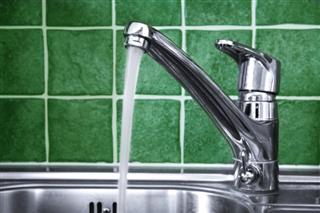Per Capita Use of Treated Municipal Water
Objective B5: Reduce the Per Capita Use of Treated Municipal Water
The following actions are needed to complete this objective:
- Develop water conservation strategies for new and existing City buildings and facilities including water re-use in outdoor and indoor recreation facilities
- Maintain existing water distribution system to reduce water loss
- Develop strategies to store stormwater for parks irrigation
- Continue to sell rain barrels at a discounted price to reduce the use of treated water for watering plants and lawn use
These indicators show the progress the City is making to achieve this objective:
- Total water consumption
Water Consumption Indicator
 Toilets, sinks, dishwashers, laundry machines and lawn watering all contribute to our water requirements. Almost all of the water we use in our homes or businesses ends up "down the drain." The treatment of water and wastewater is costly. The processes include expensive mechanical and electrical processes, requiring lots of energy to treat water for human consumption as well as to treat the wastewater generated.
Toilets, sinks, dishwashers, laundry machines and lawn watering all contribute to our water requirements. Almost all of the water we use in our homes or businesses ends up "down the drain." The treatment of water and wastewater is costly. The processes include expensive mechanical and electrical processes, requiring lots of energy to treat water for human consumption as well as to treat the wastewater generated.
A report from the United Nations predicts that by the year 2050, two thirds of the world will be living in conditions of serious water shortages and one third will be living in absolute water scarcity. The demand for water will exceed availability by 56 percent. The years 2005 to 2015 are the International Decade for Action, Water for Life.
The average residential water use in the City of Windsor is approximately 393 litres per day, which is more than double the European average of 144 litres per day.
It is important to note that communities in Canada including southern Ontario are already experiencing water shortages.
How are we doing?
The amount of water being treated indicates the amount of water used in the City of Windsor, the Town of Tecumseh and Town of LaSalle. A lower amount indicates a community that values water as a precious natural resource and is better at conserving water.
The figure below provides the average litres treated per capita per day including water used for the residential, commercial and industrial sectors.
As noted in the chart above, water consumption, measured in litres treated per capita per day, has decreased by over 200 per capita per day since 2006.
What can you do to conserve drinking water?
Water Conservation in the Yard:
- Use a rain barrel to collect rain water for gardening purposes.
- Water your lawn only when necessary. An ideal amount of water for turf is 3 to 5 cm (1.5 to 2 inches) of water per week in the summer and 2.5 cm (1 inch) per week in the spring. Frequent watering encourages shallow root growth. Try to incorporate your watering into 2 to 3 days per week.
- Water early in the morning or late at night to avoid excessive evaporation.
- Use a broom to clean sidewalks and driveways instead of a hose.
- If you choose to wash your car at home, hand wash your car with a bucket and sponge with environmentally friendly soap so you only need a light rinse of water to get rid of soap, and park your car on the lawn so the water helps the grass.
- Put a layer of mulch around trees and plants. Bark and other mulch or peat moss slows down evaporation and help keep the soil moist.
Water Conservation in the Bathroom:
- A running tap uses about 8 litres of water per minute. So, turn off the tap when you're brushing your teeth and shaving.
- Install low flow shower heads and low flow toilets to reduce consumption and generation of wastewater from your home.
- Fix leaks in your toilet and replace faulty tap washers in your sink. A tap that leaks one drop per second will waste close to 9,000 litres in a year.
- Replace your water guzzling toilet with an efficient 6 litre or dual flush toilets. If you switch from a standard toilet (19 litres) to a low-flow model (6 litres), you will reduce your water consumption by more than 75,000 litres per year. For toilets larger than 6 litres (1.3 gallons), place a plastic bottle filled with water into the tank. This reduces the volume of water in the tank but still provides enough for flushing.
Water Conservation in the Kitchen and Laundry:
- When washing dishes by hand, don't wash or rinse with running water. Use a dish, tubs or plug in the sink to rinse dishes.
- Keep a jug of drinking water in the refrigerator. This beats the wasteful habit of running the tap water to cool it before drinking.
- Always run dishwashers with a full load. This will save water, energy, detergent and money. Before loading the dishwasher, scrape dishes into the garbage instead of rinsing them with running water.
- Use a load selector on your clothes washing machine to match the water level to the size of the load. If you do not have a selector, only wash full loads.
- When replacing an old washing machine, replace it with an energy-efficient front-loading machine. Front-loading washing machines use less than half the water of conventional washers.

